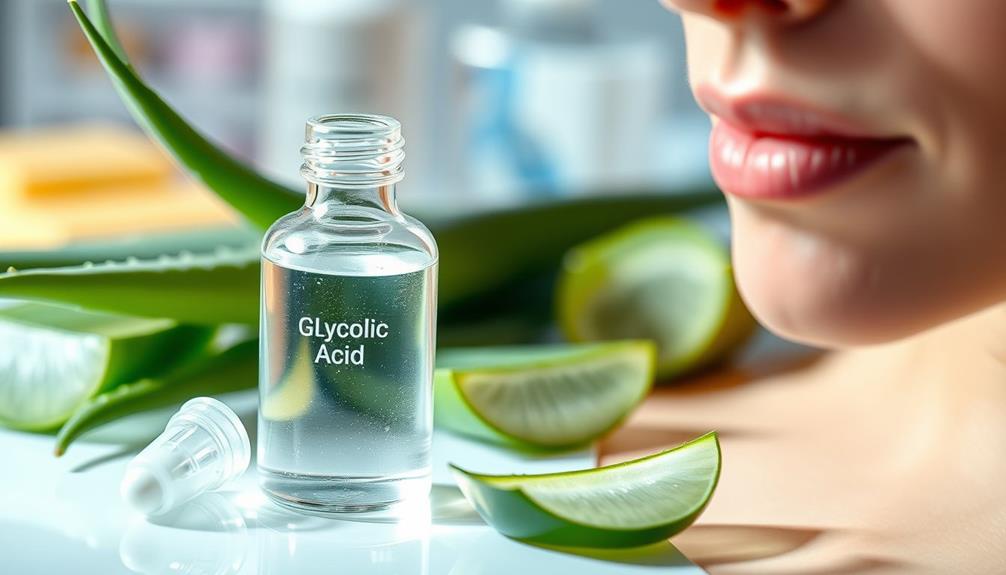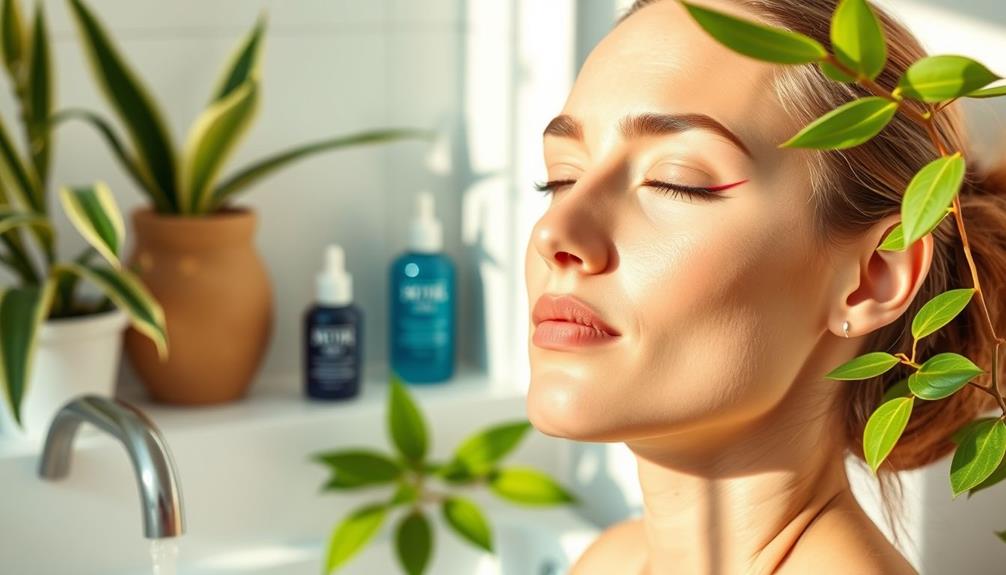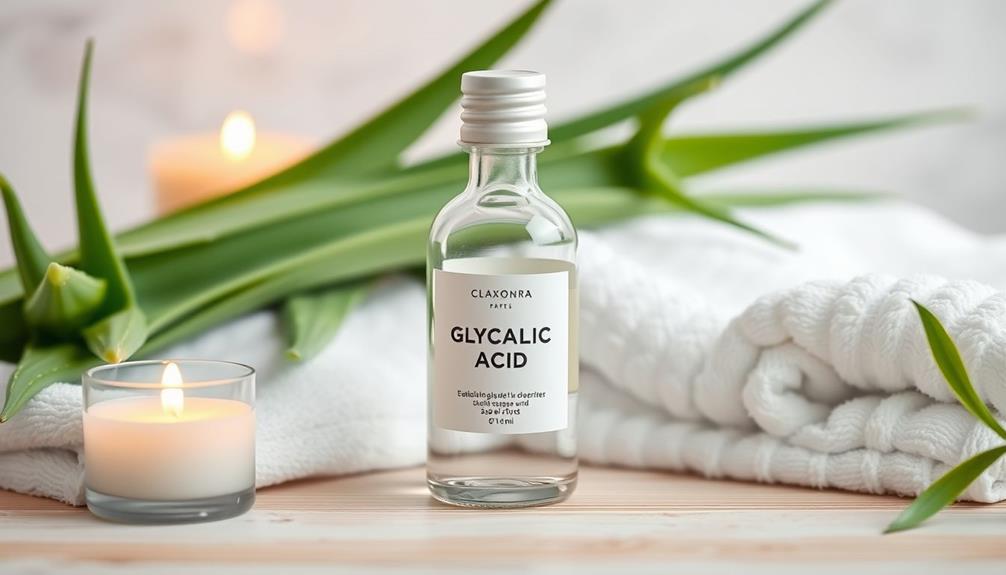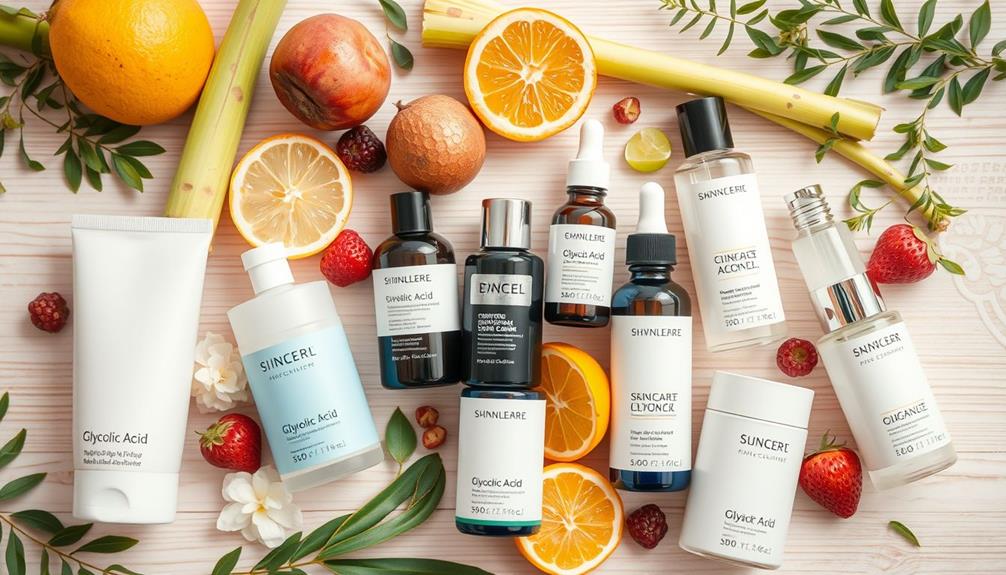Glycolic acid is a powerhouse in skincare, thanks to its ability to exfoliate and penetrate deeply into your skin. Research shows it can tackle issues like acne and melasma, with up to a 91% improvement in symptoms. It boosts collagen production, leading to improved elasticity and a more youthful appearance over time. While using glycolic acid, it's essential to start slowly and protect your skin from sun exposure, as it can increase sensitivity. You'll discover even more insights about how to use it effectively for gorgeous skin.
Key Takeaways
- Glycolic acid peels show a 90% response rate in treating acne, with significant improvements in 75%-78% of patients.
- Combining glycolic acid with hydroquinone can lead to a 91% improvement in melasma symptoms after monthly treatments.
- Clinical studies indicate glycolic acid stimulates collagen production, enhancing skin firmness and elasticity over time.
- Research suggests glycolic acid peels are better tolerated compared to Jessner's Solution and TCA peels, making them a safer option.
Understanding Glycolic Acid

Glycolic acid, the smallest alpha hydroxy acid, penetrates the skin deeply to effectively exfoliate and improve your skin's texture.
Derived from sugarcane, it stands out in the AHA family for its ability to provide intense exfoliation. This process removes dead skin cells, revealing a smoother surface and enhancing your overall skin texture.
Glycolic acid is also known for its role in acne treatment, helping to unclog pores and reduce breakouts. Additionally, it has been noted for its ability to enhance product absorption, making other skincare ingredients more effective a variety of attractions available in water parks.
One of the main benefits of glycolic acid is its ability to stimulate collagen production, which is vital for maintaining skin elasticity and combating signs of photoaging.
For best results, you'll find glycolic acid in various concentrations, typically ranging from 5% to 30%. Higher concentrations are often used in professional chemical peels, where deeper exfoliation occurs.
However, it's important to be mindful of potential skin irritation, particularly if you're new to AHAs. Products should maintain a pH between 3 to 5 to maximize effectiveness while minimizing discomfort.
Understanding these elements will help you make informed choices in your skincare routine.
Benefits for Skin Health

Glycolic acid offers impressive benefits for your skin health, making it a go-to ingredient for many.
It exfoliates to promote skin renewal, retains moisture for hydration, and boosts elasticity to combat signs of aging.
Additionally, incorporating essential oils, such as lavender oil known for its calming effects, can enhance overall skin care routines.
Let's explore how these effects can transform your skin.
Exfoliation and Skin Renewal
Exfoliating with glycolic acid helps reveal smoother, more even skin by effectively removing dead skin cells and promoting renewal. As an alpha hydroxy acid (AHA), glycolic acid works by loosening the bonds holding dead skin cells together, facilitating their shedding. This process not only enhances skin texture but also stimulates collagen production, which is essential for maintaining firmness and elasticity.
In addition, incorporating aromatherapy techniques can complement your skincare routine by promoting relaxation and enhancing overall well-being.
Regular exfoliation with glycolic acid can greatly improve skin health, especially for those dealing with acne breakouts. By keeping pores clear of excess debris and oil buildup, glycolic acid reduces the likelihood of clogged pores, leading to fewer breakouts.
Additionally, its efficacy in addressing hyperpigmentation, including melasma, has been well-documented. Studies show that glycolic acid peels can lead to a remarkable 91% improvement in melasma pigmentation when used alongside topical treatments.
Incorporating glycolic acid into your skincare routine can transform your skin, making it more radiant and even-toned. Whether you're targeting fine lines, uneven texture, or dark spots, glycolic acid offers a potent solution for skin renewal and overall brightness.
Hydration and Moisture Retention
In addition to its exfoliating properties, glycolic acid markedly enhances hydration and moisture retention, making it a valuable ingredient for achieving healthier skin. By acting as a humectant, it attracts and binds water to your skin cells, promoting a plump and hydrated appearance.
Here are some key benefits of glycolic acid for hydration:
- Improves Skin Barrier Function: Strengthens your skin's natural defenses, leading to better moisture retention.
- Enhances Skin Texture: Creates a smoother surface, reducing the visibility of fine lines and wrinkles.
- Boosts Elasticity: Encourages a more youthful bounce in your skin, contributing to overall firmness.
- Supports Long-Term Hydration: Clinical trials show that consistent use of glycolic acid in skincare products leads to sustained hydration effects.
Integrating glycolic acid into your routine can result in significant improvements in skin hydration levels. Regular use facilitates the shedding of dead skin cells while promoting the growth of fresh, hydrated skin.
Whether you're dealing with dryness or seeking to maintain a youthful glow, glycolic acid can be a game-changer for your skin health.
Anti-Aging and Elasticity Improvement
As you incorporate glycolic acid into your skincare routine, you'll notice its powerful ability to boost collagen production, helping to smooth fine lines and improve skin elasticity for a more youthful appearance.
This ingredient is particularly effective in anti-aging treatments, as it considerably reduces the appearance of wrinkles and enhances skin texture. Clinical studies have shown that consistent use of glycolic acid can lead to a remarkable 91% improvement in skin texture and tone.
Furthermore, glycolic acid acts as a humectant, enhancing hydration levels and supporting skin elasticity. By maintaining moisture, it not only contributes to a plump, rejuvenated appearance but also reinforces the skin's overall resilience.
Patients who undergo glycolic acid treatments report visible improvements in wrinkle reduction and a noticeable increase in skin smoothness.
Incorporating glycolic acid into your routine can lead to cumulative benefits, resulting in firmer, more youthful skin over time.
Safety and Precautions

When using glycolic acid, you need to be aware of potential risks like increased sun sensitivity and skin irritation.
It's essential to start with lower concentrations and monitor how your skin reacts, especially if you have sensitive skin.
Always remember to apply sunscreen to protect your skin from UV damage during and after treatment.
Sun Exposure Risks
Glycolic acid heightens your skin's sensitivity to UV radiation, necessitating strict sun protection measures. This increased sensitivity can lead to irritation and a higher risk of photodamage, especially if you're using higher concentrations of glycolic acid.
To protect your skin effectively, consider these precautions:
- Apply Broad-Spectrum Sunscreen: Use a broad-spectrum sunscreen with at least SPF 30 every day, even when it's cloudy.
- Limit Sun Exposure: Avoid direct sun exposure, particularly between 10 AM and 4 PM, when UV radiation is most intense.
- Wear Protective Clothing: Don long sleeves, wide-brimmed hats, and sunglasses to shield your skin from harmful rays.
- Use Glycolic Acid at Night: Apply glycolic acid products primarily in the evening to minimize sun-related side effects.
Neglecting these precautions can amplify your skin's irritation and lead to issues like redness and potential hyperpigmentation.
Skin Sensitivity Considerations
Many people experience increased skin sensitivity when using glycolic acid, making it crucial to take specific safety precautions. To minimize adverse reactions, start with low concentrations (around 5%) and perform a patch test. This helps you monitor for irritation or redness before applying it to larger areas. Here's a quick reference table for your safety:
| Safety Tips | Description | Importance |
|---|---|---|
| Low Concentrations | Begin with glycolic acid at 5% or lower | Reduces skin sensitivity risk |
| Patch Test | Apply a small amount on a discreet area | Detects adverse reactions early |
| Sunscreen | Use broad-spectrum SPF during and after treatment | Protects against UV damage |
| Dermatologist Supervision | Consult a dermatologist for concentrations over 10% | Guarantees safety and minimizes risk |
Concentration Guidelines
To achieve safe and effective results with glycolic acid, it's essential to understand the concentration guidelines and how they impact your skin. Here are some key points to keep in mind:
- Concentrations: Over-the-counter products typically contain 5% to 10% glycolic acid, while professional peels can range from 20% to 70%.
- Skin Irritation: Higher concentrations, especially those over 10%, may cause skin irritation or adverse reactions, particularly for sensitive individuals.
- Ideal pH: Look for products with an ideal pH of 3 to 4 to guarantee effective exfoliation while minimizing irritation.
- Gradual Introduction: Start with lower concentrations and gradually increase to allow your skin to acclimate, reducing the risk of side effects.
While using glycolic acid, avoid sun exposure as it can heighten skin sensitivity. Always apply a broad-spectrum sunscreen to protect your skin from UV radiation.
Understanding these guidelines will help you enjoy the benefits of glycolic acid while keeping your skin healthy and safe.
Choosing the Right Products

When selecting glycolic acid products, start with low concentrations around 5% to ease your skin into this powerful exfoliant. This approach minimizes irritation while allowing your skin to adapt to the ingredient.
Look for products with a pH level around 4, as this optimizes the exfoliating benefits of glycolic acid without excessive irritation.
Glycolic acid comes in various formats, including cleansers, toners, serums, and masks. However, leave-on formulations typically deliver superior results due to longer contact time.
Always conduct a patch test before using a new product, especially if you have sensitive skin. This step helps identify any possible adverse reactions before applying it to larger areas.
If you have existing skin conditions or specific concerns, consulting a dermatologist is wise. They can help you identify appropriate products and tailor your glycolic acid usage to your unique skin types.
Latest Research Insights

Recent studies shed light on the impressive efficacy of glycolic acid in treating various skin conditions, reinforcing its value in your skincare routine. Here's what the latest research reveals about this powerful ingredient: In one study, glycolic acid was found to effectively improve the appearance of acne scars and reduce the incidence of breakouts. Another study demonstrated its ability to promote collagen production and improve skin texture and tone. These findings further substantiate the benefits of glycolic acid, making it a must-have ingredient in any effective skincare regimen.
- Acne Treatment: Glycolic acid peels show a remarkable 90% response rate, with 75%-78% of patients experiencing significant improvement.
- Melasma Reduction: When combined with topical hydroquinone, glycolic acid leads to a 91% improvement in melasma symptoms after monthly treatments.
- Collagen Production: Clinical evidence supports glycolic acid's ability to stimulate collagen production, enhancing skin firmness without increasing inflammation.
- Fewer Side Effects: Research indicates that glycolic acid peels are better tolerated than Jessner's Solution and TCA peels, making them a safer option for different skin types.
These findings underscore the treatment's versatility and effectiveness, especially for those struggling with acne and melasma.
As you consider incorporating glycolic acid into your routine, it's essential to remember that each person's skin may react differently, so pay attention to how your skin responds.
With ongoing research, the potential combinations with treatments like microneedling may further enhance your results.
Application Techniques and Protocols

Applying glycolic acid correctly is vital for maximizing its benefits while minimizing potential side effects.
Start by conducting a thorough skin assessment to identify any dry patches or open sores. This guarantees safety and effectiveness during application.
You can enhance the efficacy of glycolic acid treatments through pre-peel skin priming with hydroquinone or retinoids, which helps reduce the risk of post-inflammatory hyperpigmentation.
When applying glycolic acid, use proper application techniques by working sequentially from your forehead to your cheeks, chin, and nose. This approach assures even coverage while protecting your eyes.
Follow concentration guidelines, as glycolic acid peels typically range from 20% to 70%. Remember, higher concentrations require professional supervision.
Neutralization is a significant step, occurring within 3–5 minutes, or once you observe uniform erythema. This step prevents skin acidification and potential burns, securing a safer experience.
Frequently Asked Questions
What Do Dermatologists Say About Glycolic Acid?
Dermatologists recommend starting with low concentrations of glycolic acid to minimize irritation. They emphasize combining it with other active ingredients and using sunscreen due to increased sensitivity, ensuring regular consultations to monitor your skin's reactions.
Does Glycolic Acid Age Your Skin?
You might think glycolic acid ages your skin, but it actually helps reduce fine lines and wrinkles. Just remember to use sun protection, as it can increase your skin's sensitivity to UV damage.
What Are the Bad Side Effects of Glycolic Acid?
"Better safe than sorry." Glycolic acid can irritate your skin, causing redness and stinging. Overuse might lead to increased sensitivity and hyperpigmentation, especially without sun protection. Watch for peeling, dryness, or allergic reactions.
What Does Glycolic Acid Do to the Skin?
Glycolic acid exfoliates your skin, removing dead cells for a smoother appearance. It boosts collagen production, reduces fine lines, treats acne, fades dark spots, and hydrates deeply, enhancing overall texture and radiance.
Conclusion
Incorporating glycolic acid into your skincare routine can feel like disclosing a fresher, more radiant version of yourself.
Imagine this: your skin, smooth and glowing, reflecting vibrant health with every glance in the mirror.
As you explore the latest research and choose the right products, remember to prioritize safety and application techniques.
With mindful use, glycolic acid can transform your complexion, revealing the beauty waiting just beneath the surface.
Embrace the journey to luminous skin!










